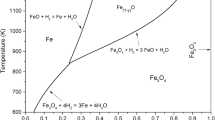Abstract
Theoretical treatment of nonisothermal kinetic studies has been extended in the present work to gas-solid reactions in powder beds. An expression for the activation energies for the reaction has been derived on the basis that the reaction proceeds by the movement of the reaction front, the velocity of the movement being kept constant. The reliability of the method has been tested by applying the same to the reduction of tungsten oxide by hydrogen. The experiments were carried out using thermogravimetric technique under both isothermal and nonisothermal conditions. The reaction front is considered to consist of a thin layer of small particles. The rate of the reduction seems to be controlled by the chemical reaction between the product and the unreacted core existing in each of the small particles. Using the expression derived in the present work, the activation energy of the reaction was calculated from the results of the nonisothermal experiments to be 83.62 kJ · mol−1. This value is in good agreement with the value of 83.17 kJ · mol−1 evaluated from isothermal experiments.
Similar content being viewed by others
Abbreviations
- A, B:
-
reacting species
- b:
-
stoichiometric constant
- C1, C2 :
-
constants
- CA :
-
concentration of gasA, mole · cm−3
- E, F:
-
product species
- e, f:
-
stoichiometric constants
- h:
-
height of the bed, cm
- k:
-
reaction rate constant, cm · s−1
- MB :
-
molecular weight of speciesB, g · mole−1
- Δm:
-
mass change, g
- Q:
-
activation energy, J · mole−1
- r:
-
radius of particle, cm
- t:
-
time, s
- tf :
-
time required for complete reaction of a single particle, s
- v:
-
velocity of the moving reaction interface, cm · s−1
- W0 :
-
initial weight, g
- Wt :
-
weight at timet, g
- W∞:
-
weight when reaction is completed, g
- ΔW:
-
dimensionless mass change
- ΔW∞:
-
dimensionless mass change when reaction is completed
- y:
-
distance, cm
- ρ:
-
density of speciesB, g · cm−3
References
Du. Sichen and S. Seetharaman:Metall. Trans. B, 1992, vol. 23B, pp. 317–24.
J. Szekely, J.W.M. de Jonge, and H.Y. Sohn:Gas-Solid Reaction, Academic Press, New York, NY, 1976, pp. 642–45.
J.M. Smith:Chemical Engineering Kinetics, 3rd ed., McGraw-Hill Book Company, New York, NY, 1981, pp. 643–47.
M.S. Whittingham and P.G. Dickens: inProc. 7th Int. Symp. on the Reactivity of Solids, Bristol, United Kingdom, Chapman & Hall, London, 1972, pp. 640–50.
T. Millner:Acta Tech. Acad. Sci. Hung., 1957, vol. 17, pp. 67–112.
D.S. Parsons:Electrochem. Tech., 1965, vol. 3, pp. 280–83.
J. Haber, J. Stoch, and L. Ungier:J. Solid State Chem., 1976, vol. 19, pp. 113–15.
K. Kashida, K. Goto, and M. Someno:Trans. TMS-AIME, 1968, vol. 242, pp. 82–87.
B. Phillips and L.L.Y. Chang:Trans. TMS-AIME, 1964, vol. 230, pp. 1203–06.
Author information
Authors and Affiliations
Rights and permissions
About this article
Cite this article
Bustnes, J.A., Sichen, D.U. & Seetharaman, S. Application of a nonisothermal thermogravimetric method to the kinetic study of the reduction of metallic oxides: Part II. A theoretical treatment of powder bed reduction and its application to the reduction of tungsten oxide by hydrogen. Metall Trans B 24, 475–480 (1993). https://doi.org/10.1007/BF02666430
Received:
Published:
Issue Date:
DOI: https://doi.org/10.1007/BF02666430




